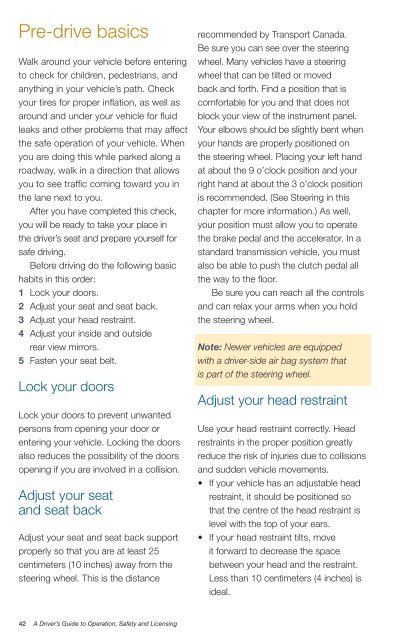DRIVER’S GUIDE
1POl7Ob
1POl7Ob
You also want an ePaper? Increase the reach of your titles
YUMPU automatically turns print PDFs into web optimized ePapers that Google loves.
Pre-drive basics<br />
Walk around your vehicle before entering<br />
to check for children, pedestrians, and<br />
anything in your vehicle’s path. Check<br />
your tires for proper inflation, as well as<br />
around and under your vehicle for fluid<br />
leaks and other problems that may affect<br />
the safe operation of your vehicle. When<br />
you are doing this while parked along a<br />
roadway, walk in a direction that allows<br />
you to see traffic coming toward you in<br />
the lane next to you.<br />
After you have completed this check,<br />
you will be ready to take your place in<br />
the driver’s seat and prepare yourself for<br />
safe driving.<br />
Before driving do the following basic<br />
habits in this order:<br />
1 Lock your doors.<br />
2 Adjust your seat and seat back.<br />
3 Adjust your head restraint.<br />
4 Adjust your inside and outside<br />
rear view mirrors.<br />
5 Fasten your seat belt.<br />
Lock your doors<br />
Lock your doors to prevent unwanted<br />
persons from opening your door or<br />
entering your vehicle. Locking the doors<br />
also reduces the possibility of the doors<br />
opening if you are involved in a collision.<br />
Adjust your seat<br />
and seat back<br />
Adjust your seat and seat back support<br />
properly so that you are at least 25<br />
centimeters (10 inches) away from the<br />
steering wheel. This is the distance<br />
recommended by Transport Canada.<br />
Be sure you can see over the steering<br />
wheel. Many vehicles have a steering<br />
wheel that can be tilted or moved<br />
back and forth. Find a position that is<br />
comfortable for you and that does not<br />
block your view of the instrument panel.<br />
Your elbows should be slightly bent when<br />
your hands are properly positioned on<br />
the steering wheel. Placing your left hand<br />
at about the 9 o’clock position and your<br />
right hand at about the 3 o’clock position<br />
is recommended. (See Steering in this<br />
chapter for more information.) As well,<br />
your position must allow you to operate<br />
the brake pedal and the accelerator. In a<br />
standard transmission vehicle, you must<br />
also be able to push the clutch pedal all<br />
the way to the floor.<br />
Be sure you can reach all the controls<br />
and can relax your arms when you hold<br />
the steering wheel.<br />
Note: Newer vehicles are equipped<br />
with a driver-side air bag system that<br />
is part of the steering wheel.<br />
Adjust your head restraint<br />
Use your head restraint correctly. Head<br />
restraints in the proper position greatly<br />
reduce the risk of injuries due to collisions<br />
and sudden vehicle movements.<br />
• If your vehicle has an adjustable head<br />
restraint, it should be positioned so<br />
that the centre of the head restraint is<br />
level with the top of your ears.<br />
• If your head restraint tilts, move<br />
it forward to decrease the space<br />
between your head and the restraint.<br />
Less than 10 centimeters (4 inches) is<br />
ideal.<br />
42 A Driver’s Guide to Operation, Safety and Licensing


